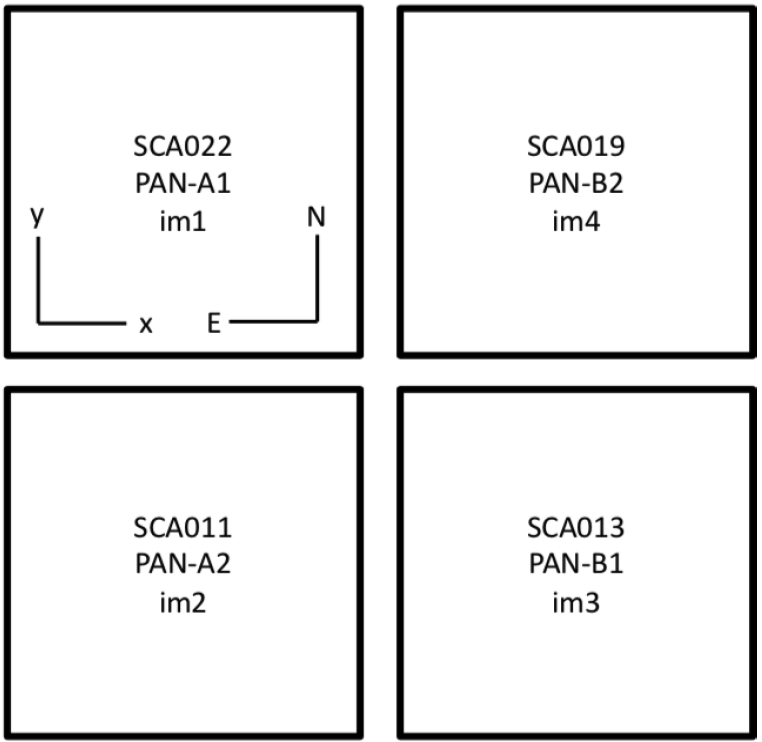NEWFIRM Characteristics
Quick Guide for Proposal Preparation
NEWFIRM is a 1-2.4 micron IR camera installed at the CTIO 4-m V. M. Blanco telescope. It has a flexible complement of broad and narrow band filters, a dedicated guider, and the largest field of view available at the f/8 R-C focus without vignetting by the telescope structure.
Availability and scheduling
NEWFIRM is permanently mounted in the CTIO 4-m Blanco telescope Cass cage except when it has been removed to change filters (Please read the NEWFIRM filter availability and filter change policy here). Both standard and survey proposals may be proposed. NEWFIRM will be available for regular science observations starting in the 2024A semester. NEWFIRM will be scheduled on the telescope in accordance with community demand.
Geometry
The detector focal plane consists of four 2048 x 2048 arrays arranged in a 2 x 2 mosaic. Figure 1 illustrates the layout of the four NEWFIRM arrays, their orientation with respect to the sky, and their storage within multi-extension FITS (MEF) files, an implemented at the Blanco telescope in January 2023. The raw FITS images have 2112 columns and 2048 rows in each extension. The last 64 columns (2049 to 2112) are "reference pixels" and are not illuminated. The orientation of the arrays is fixed; the instrument cannot be rotated.

Field of view: 27.6 x 27.6 arcmin including a 35 arcsec wide, cross-shaped gap between the arrays composing the mosaic.
Sampling: 0.40 arcsec/pixel
Filters: There are more NEWFIRM-specific filters than can be accommodated in the Dewar at one time. A set broadband and narrowband filters has been tested on-sky in NEWFIRM and is presently installed in the instrument. Performance data are tabulated below.
- Broadband: J, H, Ks
- Narrowband: 1.64 mum [FeII], 2.12 mum H2, 2.17 mum Br gamma
Broadband filters follow the "MKO" prescription of Tokunaga et al. PASP, 114, 180, 2002. A J, H, Ks filter set will remain permanently installed in the Dewar.
The narrowband filters are designed to capture the designated emission-line feature with high transmission over the field of view at zero redshift. Resolution is about 1.3%. The filter bandpass shifts in wavelength with radial position in the field of view. At field center, the designated line falls near the blue edge of the high transmission window; at the field corners, near the red edge.
The 1.64 mum [FeII] filter may also be used in conjunction with broadband H for o/off methane band detection of brown dwarfs. The bandpass will shift across the methane absorption edge from field center to field corner as noted above.
The complete NEWFIRM filter page is found here.
Signal levels on star and sky for broadband and narrowband filters:
Important signal level performance issues for proposal planning:
- Array SCA019 should have a reduced response in the J and H bands compared to the other arrays, due to a different anti-reflection coating on this array. We have not detected any significant difference in the July 2023 engineering data. We will continue to investigate this.
- The J sky background varies substantially with angular distance between the field of view and the Moon
- The Ks sky background varies substantially with sky temperature, e.g. between summer and winter.
J and H band performance are tabulated separately for array SCA019.
| Filter | J | H | Ks Summer (22 C) |
Ks Winter (12 C) |
|
Counts. on a 10.0 mag |
8.5E5 | 8.9E5 | No data | 4.2E5 |
| Sky background e-/sec-pixel (2) |
395 | 2460 | No data | 2310 |
| Zero Points: mag corresponding to 1 ADU/sec |
22.6 | 22.7 | No data | 22.0 |
| Brightest star observable, mag (3) |
10.7 | 10.9 | No data | 10.1 |
| Faintest star, 3-sigma in 60 sec, mag (4) |
20.4 | 19.7 | No data | 19.0 |
Notes:
(1) Vega = 0.00 mag; scaled from 2MASS stars in the field (~15 per array varying between 11 < J < 16)
(2) J levels are for 50-60 degrees away from full Moon
(3) Assumes 1.7 sec integration time and well depth corresponding to 25% nonlinearity correction at peak pixel level)
(4) Integrated over 40 pixel (3 arcsec) aperture; sky brightness as tabulated and no S/N degradation from sky subtraction. Vega magnitudes.
These filters have not been fully commissioned. The values in the table below are from NEWFIRM on the Mayall 4-m telescope at KPNO. The analysis of the JHKs filters show about a 10% decrease between now and when NEWFIRM was at KPNO. The values below can be adjusted accordingly. We will update this table as we obtain more data.
| Filter Name | 1644 nm [FeII] | 2124 nm H2 | 2168 nm Brγ |
| λeff, μm | 1.644 | 2.124 | 2.168 |
| Bandpass, μm (1) | 0.015 | 0.020 | 0.020 |
| Sky background e-/sec-pixel |
145 (SCA019) | 190 (summer) | 255 (summer) |
| 165 (others) | 115 (winter) | 130 (winter) | |
| Counts on 10.0 mag F6 star, e-/sec (2) |
4.9E4 (SCA019) | 3.7E4 | 3.2E4 |
| 5.6E4 (others) | |||
| Flux density of 10.0 mag star, mJy (3) |
104 | 68 | 66 |
| Flux density of 10.0 mag star, W m-2 μ-1 (3) |
1.2E-13 | 4.5E-14 |
4.2E-14 |
(1) Bandpass at 90% of maximum transmission. FWHM is typically 1.2x wider.
(2) Vega = 0.00 mag
(3) Derived from Tokunaga and Vacca (PASP, 117, 421, 2005) flux densities for MKO broadband filters, with scaling to effective wavelengths for a 6400 K star. Vega magnitude.
Figure 2 shows the increase in J bband sky background, under full Moon, as the angular distance between the telescope pointing and the Moon decreases. The Y-axis gives the multiplier for the J band background levels quoted in Table 1. It is very difficult to shield the telescope truss structure from moonlight. At angular distances less than about 20 degrees, the primary mirror is directly illuminated.
Lunar phase and distance from the target fields should be considered when specifying the range of acceptable scheduling dates for a proposal.

Non-MSO filters
The non-MSO filters listed in Table 3 were purchased by individual researchers for potential use with NEWFIRM. Whether or not programs requesting these filters will be scheduled depends on the recommendations of the TAC and the feasibility of scheduling them for use. All of the owners of these filters have released their restrictions on their use by the wider community. Please see the NEWFIRM filter page concerning the filter availability and filter change policy.
Signal levels on star and sky generally scale relative to the J and H filters in proportion to bandpass. The ultra-narrowband 1056 nm and 1063 nm filters are located in OH line-free regions so the sky background is minimal. Detection sensitivity with the filters will likely depend on systematic effects with sky background and readout electronics, rather than on photon statistics or read noise.
| Name | λ0 μm | Bandpass μm |
| 1187 nm | 1.186 | 0.011 |
| 2096 nm | 2.096 | 0.020 |
| J1 | 1.048 | 0.161 |
| J2 | 1.190 | 0.153 |
| J3 | 1.284 | 0.152 |
| H1 | 1.556 | 0.175 |
| H2 | 1.710 | 0.168 |
| 1056 nm | 1.0564 | 0.0007 |
| 1063 nm | 1.0631 | 0.0008 |
Detector performance and cosmetics
NEWFIRM uses four, 2048 x 2048 ORION InSb arrays produced by Raytheon Vision Systems. Arrays are characterized in CTIO's Infrared Detector Test Lab as well as at the telescope.
| Item | Result | Unit |
| Noise1 | 45 | e- |
| Noise4 | 22.5 | e- |
| Gainlow | 7.5 | e- ADU-1 |
| Gainhigh | 9.9 | e- ADU-1 |
| Well | 100 | Ke- |
| NL100Ke | <2 | % |
| Dark30k | 0.18 | e- pix-1sec-1 |
| IPC | 2.9 | % |
| Hot pixels | 0.0014 | % |
| Persistence tc | 12 | sec |
A more thorough review of the detector properties is found on the NEWFIRM detector web page.
Illumination issues
- A ~300 pixel diameter ghost, 17 mag.sq arcsec fainter than the integrated magnitude of the source star. Offset from the source radially with respect to the field center by hundreds of pixels. The offset depends upon the source distance from the field center.
- A ~100 pixel diameter ghost, 14 mag/sq arcsec fainter than the integrated magnitude of the source star and nearly centered on it.
- A compact star-like ghost (~4 pixels FWHM), 8.5 magnitudes (integrated) fainter than the source, offset radially from it by hundreds of pixels in a field position-dependent manner.
Given the ~10 mag dynamic range of the arrays, ghost #1 may be detectable only for the brightest stars (3-5 mag). Its size makes it difficult to remove by dithering. However, both its location and surface brightness are predictable.
Ghost #2 may produce compact, low level "nebulosity" around somewhat fainter stars (7-8 mag).
Ghost #3 has the potential of producing false "field stars". Fortunately, a modest dither pattern of tens of arcseconds shifts the ghost by more than its FWHM, so it will not likely appear in a median-combined image.
The pipeline reduction team is investigating how to best handle ghost suppression in the data reduction.
Residual images (sometimes called "retained charge" or "charge persistence"): Very bright stars may produce faint residual images at the same locations in subsequent dithered frames. These residual images fade into the background sky noise over the course of subsequent array reads. From experiments with bright stars, these residuals appear to be ~12 mag (integrated) fainter than the source star. Structure is smooth and flat within the outer contour of the originating star's PSF. Flux is ~10 electrons per second per pixel in the first subsequent frame, decaying to a few electrons per second per pixel in following frames. We are investigating means to remove these effects when shifting and combining images in the pipeline reduction software.
System operational and efficiency issues
Minimum integration time = readout time n.n seconds with one Fowler sample.
Coadding is supported. This reduces data volume with short integration times necessary for broadband H and Ks observations.
Fowler sampling (multiple nondestructive reads) is supported. The minimum exposure time becomes n.n x number of samples. This technique reduces read noise if it is a significant noise source, e.g., with narrowband filters.
Updated on April 18, 2024, 10:19 am